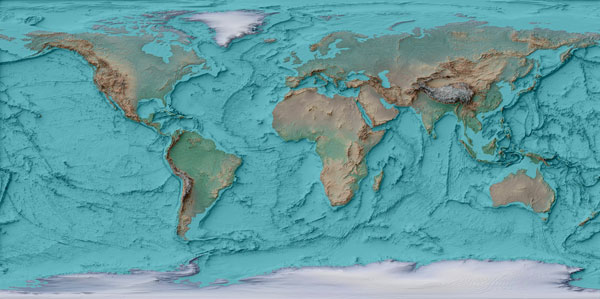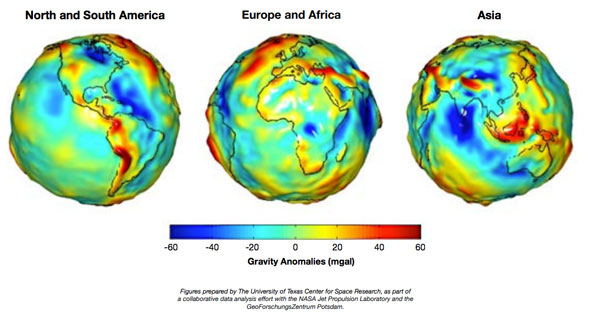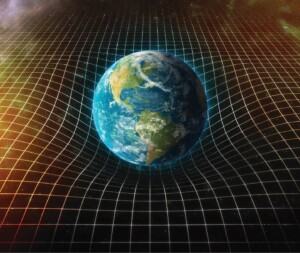Earth’s Gravitational Field
A Carolina EssentialsTM Activity

Total Time: 30 mins
Prep: 15 mins | Activity: 30 mins

Physical Science, Earth and Space Science
9-12
High School
- Total Time: 60 minutes [ Prep: 15 mins | Activity: 30 mins ]
- Subject: Physical Science, Earth and Space Science
- Grade: High School
Overview
Looking at Earth’s gravitational field is an interdisciplinary application of Newton’s law of universal gravitation and gravitational field strength concept. This activity illustrates the application of gravitational field strength to changes in topography across the Earth’s surface.
If Newton could have traveled across the entire Earth’s surface measuring the acceleration due to gravity, he would have discovered the same patterns shown in the GRACE satellite images. Today, the GRACE 1 and GRACE 2 satellites, traveling in tandem and very close together, take the necessary measurements and complete the analysis of gravitational field strength.
This activity drives home the relationship between mass and gravity through a simple visual examination that Newton established hundreds of years ago. Students should be familiar with the force of gravity, Fg, and acceleration due to gravity, g, the mathematical relationships established in both, and the interpretation of the values.
Newton demonstrated that the force of gravity, Fg, between two objects is attractive, directly proportional to the product of their masses, m1 and m2, and inversely proportional to the distance, d, between them squared.

The masses of objects and the distance between them are key considerations for understanding the strength of the gravitational force. Newton’s formula can be applied to very large bodies like the Earth and moon system or even the Earth and sun system because of the substantial masses of the objects and the distances between them.
For less massive bodies on or near the Earth’s surface, we often use the local gravitational field of Earth, or g, the attractive force a body placed in Earth’s gravitational field experiences. The gravitational field strength at a given point is calculated as the gravitational force per unit of mass or:
g=F/m g=9.80665 N/kg F=in Newtons m=mass in kg
Since gravity is an attractive force and bodies near the Earth’s surface fall to Earth, g is also referred to as the average acceleration due to gravity. At sea level, the standard acceleration of gravity is 9.80665 m/s2. Latitude, altitude, and local geology can impact the value of g. Local variations in values of g are called anomalies. They are measured in units of milliGalileo, mgal, which has an acceleration value of about 1 × 10-6 g or 1 × 10-5 m/s2. The maps provided are color coded to indicate areas with higher (red), or lower (blue), than expected values of g. With imaging from GRACE satellites and a shaded relief map, students can establish and confirm patterns among Earth’s gravitational acceleration, topography, and geology. By examining gravitational anomalies compared to relief features, students quickly identify and confirm the relationship Newton established between mass and gravitational field strength.
Phenomenon
What can you tell about the distribution of mass on Earth by looking at a relief map?

Essential Question
How can variations in Earth’s gravitational force be explained and predicted?
Activity Objectives
- Using GRACE satellite data, explain variations (anomalies) and patterns in Earth’s gravitational field.
- Explain how the gravity field anomalies could be addressed by Newton’s law of universal gravitation.
Next Generation Science Standards* (NGSS)
HS-PS2-4. Use mathematical representations of Newton’s law of gravitation and Coulomb’s law to describe and predict the gravitational and electrostatic forces between objects.
SCIENCE & ENGINEERING PRACTICES
Using Mathematics and Computational Thinking
- Use mathematical representations of phenomena to describe explanations.
DISCIPLINARY CORE IDEA
PS2.B: Types of Interactions
- Newton’s law of universal gravitation and Coulomb’s law provide the mathematical models to describe and predict the effects of gravitational and electrostatic forces between distant objects.
CROSSCUTTING CONCEPTS
Patterns
- Different patterns may be observed at each of the scales at which a system is studied and can provide evidence for causality in explanations of phenomena.
Materials
Safety Procedures and Precautions
No PPE is required for the activity.
Teacher Preparation and Disposal
Prepare student guide by printing or uploading to a class site. Print or upload a relief map for student use. You may wish to print and laminate the magnetic field maps to reuse with other classes or activities.
SCIENCE & ENGINEERING PRACTICES
- Carefully examine the 3 gravity field maps of the different regions of the world. Notice that the key is for gravity anomalies, a difference in values (milligal, or mgal, used as the unit for acceleration in the science of gravimetry) above or below the expected value for a featureless, uniform surface on Earth.
- Record any variations or patterns you notice.
- Compare the gravity field maps to a world relief map.
- Record any variations or patterns you notice.
TEACHER PREPARATION AND TIPS
- Review with students what a map showing anomalies means.
- Go over the key of the gravity field map so students understand how to interpret it.
Data and Observations
1. Gravity field map observations
Student answers may vary, but students should see the obvious differences between ocean and terrestrial gravity field strength. The Atlantic and Pacific tend to be below average gravity field strength, and continents tend to be above average strength. The exceptions are central Asia and the Amazon basin, which are also below average in gravity field strength.
2. Gravity field map and relief map comparisons
Student answers may vary. Positive anomalies are associated with mountain ranges. Note the Rockies, Andes, Alps, and Himalayans. Large river basins like the Mississippi, Amazon, and Nile appear slightly below average, which makes sense because the rivers and large, extended flood plains do not have a buildup of mass. The Arctic and Antarctic have positive anomalies.
Analysis & Discussion
How can Newton’s law of universal gravitation be used to explain the anomalies in the global gravity field map? Use the table of densities to help support your claims.
Newton’s law of universal gravitation has the mass of 2 objects in the numerator. Based on the global gravity field maps and topographic or relief maps, it is apparent that mass is not evenly distributed across the globe. Water is less dense than the rocks that make up continents, which means that for the same amount of volume, water has less mass than rock.
As rock builds up or erodes away, mass is redistributed. As mass is redistributed, the gravity field changes. For example, as mass increases, like along a mountain chain, the magnetic field strength should increase. This is supported by the red color on the gravity field map indicating a positive anomaly. A decrease in mass or high volume of water, like in the Amazon basin, shows a negative anomaly since water is less dense than rock.


SHOP THE KIT
HELPFUL LINKS
RESOURCES
VIEW MORE ESSENTIALS
*Next Generation Science Standards® is a registered trademark of Achieve. Neither Achieve nor the lead states and partners that developed the Next Generation Science Standards were involved in the production of, and do not endorse, these products.







